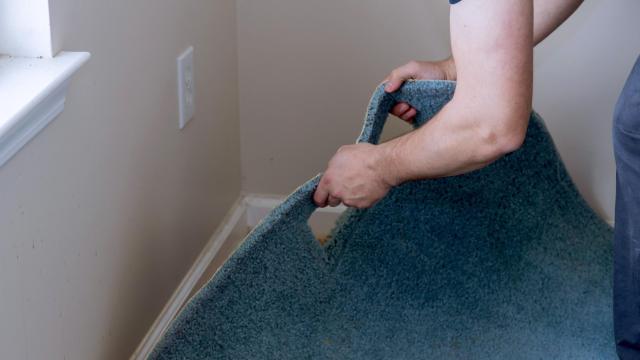If you aren’t the first owner of your home, you are likely to encounter out-of-date and worn carpeting. But sometimes, if you’re lucky, there are beautiful hardwood floors under the old carpet that are just crying out for their chance to shine once more. The tricky part, though, is removing the old carpet padding without damaging the hardwood in the process.
How to prep the surface of your hardwood floor
Before you start scrubbing, check the floor for staples. You can save your knuckles some abuse and make the clean-up simpler by removing any carpet tacks or staples from the floor. To avoid damaging your floor, you should slide a wooden stir stick under the pliers and push against that instead of the floorboard. Then, scrape away any large chunks or loose bits of the old foam padding with a plastic paint scraper.
Try heat first
Before you try any solvents, get out your hair dryer and set it to high. Try heating up the foam residue and scraping it away with your plastic scraper. Although this method won’t work on all adhesive types, it’s the least toxic method for removing the stubborn mess. Alternatively, you can also use a heat gun, but make sure the setting isn’t high enough to burn yourself or the floor while you’re scraping. If heat doesn’t do the trick, you can move on to solvents.
Next, dish soap and water
There are quite a few solvents you can use to dissolve carpet foam once you’ve prepped your floor. One simple option is dish soap mixed with a little warm water. This requires some patience, but it can be effective at removing the caked-on foam residue. To avoid damaging your hardwood with too much water, use a dampened sponge to spread the dish soap over the leftover padding. Allow the soap to soak in enough to loosen the foam in a small area, and scrape it away with your paint scraper. Next, rinse the area and dry it to keep the water from damaging the floorboards. Work your way across the rom in small sections.
Or maybe you need a stronger solvent
If dish soap and water isn’t strong enough, you can also give mineral spirits or denatured alcohol a try. These products are used to dissolve latex paint and are often safe on floor finishes. To make sure, though, do a small test patch in the back corner of a closet or other hidden area before you begin. Using gloves, apply the solvent to the foam residue with a cloth, allow it to penetrate the leftover padding, and then scrape it away with your paint scraper. Although mineral spirits are low odor, the fumes aren’t good for you, so make sure to allow for good air circulation or wear a respirator to prevent exposure. Also, be aware that these chemicals are flammable, so make sure to store and use them safely.
If all else fails, sand it off
Your last option, if all else fails is to sand the residue away. This is what might be referred to as the “nuclear option” because you will definitely need to refinish your floors after this process. The up side to sanding and refinishing is that you’ll get a like-new shine with less knuckle-busting work.

Leave a Reply
You must be logged in to post a comment.